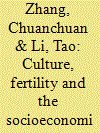|
|
|
Sort Order |
|
|
|
Items / Page
|
|
|
|
|
|
|
| Srl | Item |
| 1 |
ID:
156471


|
|
|
|
|
| Summary/Abstract |
This paper aims to study the effect of culture on economic outcomes by focusing on one unique fertility norm in China: the belief of continuing the family line. Using the national representative household survey data, we successively examine the fertility behavior and socioeconomic status of women in regions of China with varying beliefs regarding continuing the family line. We show that this local fertility norm has positive and significant effects on the fertility behavior, including the number of births; sex selection biased towards boys; and the education, employment status, and income of women. We also show that the gender gaps in education, labor supply, and income are significantly larger in regions where the belief of continuing the family line is stronger. Our results are robust to the control for reverse causality issue by measuring the local fertility norm using the beliefs of the older generation.
|
|
|
|
|
|
|
|
|
|
|
|
|
|
|
|
| 2 |
ID:
149777


|
|
|
|
|
| Summary/Abstract |
This paper examines the effect of the New Rural Pension Scheme (NRPS) on the labor supply behavior of the elderly in rural China. Using pooled data from two waves of the China Health and Retirement Longitudinal Survey (CHARLS) and an analytical framework of combination of regression discontinuity design and difference in difference method (RD-DiD), we find no evidence that pension receipt from the NRPS program does significantly induce the elderly to withdraw from the labor market. The heterogeneous effects by health status indicate that pension recipient slightly decreases the probability of labor force participation for those individuals with chronic diseases; however, the effect is not statistically significant. The empirical findings suggest that the introduction of the NRPS program does not improve the welfare effect of the originally targeted elder individuals with illness.
|
|
|
|
|
|
|
|
|
|
|
|
|
|
|
|
| 3 |
ID:
182734


|
|
|
|
|
| Summary/Abstract |
This paper studies the effect of family size on parents' labor supply and occupational prestige, using the censuses of both Taiwan and Mainland China. We rely on the exogenous increase in child quantity that results from having twins at the first birth. Our results indicate that an increase in family size has negative effects on the labor supply of mothers but not of fathers, in both Taiwan and Mainland China. In addition, we find that in Taiwan fathers tend to switch to occupations with lower prestige scores in response to an increase in family size. However, the negative effect of family size on occupational prestige is not observed in Mainland China, where the occupational mobility is low.
|
|
|
|
|
|
|
|
|
|
|
|
|
|
|
|
| 4 |
ID:
192320


|
|
|
|
|
| Summary/Abstract |
This study investigates the relationship between family size and parents’ labor market performance, measured by labor supply and occupational prestige scores, based on three census waves in 1990, 2000, and 2010. To address the endogeneity problem of family size, we use the indicator of twins at first birth as an instrumental variable. Our results suggest that in nuclear households, family size affects the labor market performance only of mothers, not of fathers, with the negative effects fading and gradually disappearing over time. More specifically, an increase in family size decreases female labor supply in the 1990 wave, leads to lower prestige scores among working mothers in the 2000 wave, and has no impact on labor supply or occupational prestige scores in the 2010 wave. Our subsample analysis indicates that the negative effects of family size are more severe for parents of households with all children under seven years old and for husbands or wives with lower education level than that of their partners. In addition, we find that the negative effects of family size on parental labor market outcomes are not observed in extended households, especially when no grandparents are aged 65 years or older.
|
|
|
|
|
|
|
|
|
|
|
|
|
|
|
|
| 5 |
ID:
171015


|
|
|
|
|
| Summary/Abstract |
The success of military recruiting depends largely on the potential consequences of military services. This study examines how military service affects labor market outcomes of veterans. Specifically, I focus on how the Transition Assistance Program (TAP), a career assistance program, help military personnel transition to the civilian labor market. To identify the effects of TAP, I exploit variation in program accessibility generated by its initial rollout process. Using data from the Current Population Survey, I find that TAP improves the labor market outcomes of veterans, measured approximately ten years after separation. Specifically, it leads a significant increase in labor force participation. One possible mechanism is that TAP encourages the use of the GI Bill, a program that provides financial assistance to attend institutions of higher education.
|
|
|
|
|
|
|
|
|
|
|
|
|
|
|
|
| 6 |
ID:
099408


|
|
|
|
|
| Publication |
Washington, DC, World Bank, 2008.
|
| Description |
xviii, 247p.
|
| Series |
WBI development studies
|
| Standard Number |
9780821374382
|
|
|
|
|
|
|
|
|
|
|
|
Copies: C:1/I:0,R:0,Q:0
Circulation
| Accession# | Call# | Current Location | Status | Policy | Location |
| 055317 | 338.0640981/ROD 055317 | Main | On Shelf | General | |
|
|
|
|
| 7 |
ID:
078036


|
|
|
|
|
| Publication |
2007.
|
| Summary/Abstract |
Empirical models are developed in this paper to quantitatively analyze households' participation in decisions on hiring labor and supplying labor off the farm, hired labor demand and off-farm labor supply of rural Chinese households. Econometric estimates use micro-level data from Zhejiang province over the period 1995-2002. The main results suggest that the decisions to hire labor and participate off the farm are made jointly and are positively correlated. A household's labor demand decreases with increasing wages for hired labor, whereas the effect of the wages of off-farm workers on a household's labor supply differs significantly depending on the household's kind of labor market participation. The results also indicate that the accumulation of productive assets, the development of livestock production and agricultural prices have increasing effects on labor demand but reducing effects on a household's off-farm labor supply. Land market integration enhances participation significantly but has no significant impact on time allocation. Finally, the results suggest non-separability between hired labor demand and household characteristics, indicating the rural labor market in Zhejiang province is still functioning imperfectly
|
|
|
|
|
|
|
|
|
|
|
|
|
|
|
|
| 8 |
ID:
119211


|
|
|
|
|
| Publication |
2013.
|
| Summary/Abstract |
This paper estimates the labor supply functions for health care professionals in China using Census-based data in 2005. The rapid economic growth and population aging in China led to a substantial increase in the demand for health care services and the derived demand for health care professionals in recent years. However, the increase in the supply of doctors and nurses lags behind the growth in demand, raising the question of whether the excess demand should be met by expanding the health care manpower or by inducing the existing personnel to work more hours through wage increase. Our findings indicate that wage rate adjustment has a significant impact on the length of working time among the self-employed practitioners (with an estimated short-run elasticity of 0.575), while the labor supply of hospital employees is inelastic due to their fixed payment scheme. Instead, hours worked in the employee group are related to non-wage factors such as asset holdings and the hospital ownership type. An important policy implication of our study is that adjustments of labor compensation methods and hospital ownership structure are potentially effective approaches for coping with the excess demand for health care professionals and improving the quality of health care in China.
|
|
|
|
|
|
|
|
|
|
|
|
|
|
|
|
|
|
|
|
|